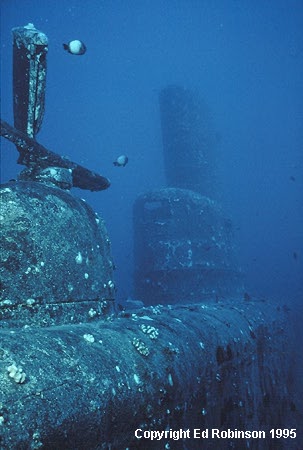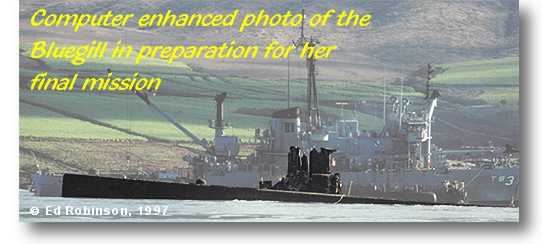by Ed Robinson

Beneath the ocean, a mile and a half off of Lahaina, a massive relic of World War II resided for thirteen years. The USS Bluegill (SS-242), one of the Navy's Gato class of submarine, hid beneath the shroud of blue Pacific water. Her keel rested on the sand, 135 feet below; the top of her sail was 80 feet beneath the warm Hawaiian Trades.
Her powerful electric motors had pushed her across countless miles of ocean during her 28 year career. During WWII she claimed 46 thousand tons of enemy shipping. Then in 1953 her hull was modified and she was converted to SSK (Killer Sub). She was used as a training vessel during the following years until the Vietnam War.
According to Buck McCalla, Machinist's Mate: "In 1965 we spent a great deal of time in the Tonkin Golf. The purpose of our mission was reconnaissance and pilot rescue. Although we never rescued any pilots ditched at sea, we did spend the period February 1, 1965 to March 30, 1965 submerged mostly off the coast of Hanoi."
After Vietnam, she was placed out of commission, and then in 1971 she was scuttled by the Navy to be used for underwater rescue training.
Her motors were silenced, along with the ping of her sonar, and the clang of her hatches as she prepared to dive. Her 312 foot bulk was not doomed to eternal retirement however.

Moored to the bottom so the currents and storm surge could not move her, the Bluegill had many visitors. Large schools of weke (goatfish) swarmed above and below her wooden deck. Beneath her deck, and throughout the vast expanse of crevices and dark nooks, hid eels, lobsters, and many other animals of the deep. Often graceful eagle rays could be seen swimming past her.

Divers too came for short visits; some to look and photograph; some to hunt for small treasures and several times each year Navy divers used her in their training exercises.
I had the pleasure of diving her many times during the years she was off Lahaina. The feelings were always a mixture of awe and excitement. Numerous times I penetrated her through the only accessible hatch leading into the forward torpedo room.

As I descended into the interior, an unmistakable taste of sulfur would always seep through my mask and regulator. I believe that because there was only one opening into the interior the water inside the closed system had become stagnant. With all oxygen used up, anaerobic bacteria created the strong smell of rotting eggs.
As my light pierced the milky water and darkness, the sight of machinery of war would engage my imagination. The torpedo tubes, surrounded by pipes, knobs and gauges, were the scene my light painted toward the bow. Aft, in the other direction a narrow passageway led past small rooms and ended in a closed hatch. As hard as I attempted to turn the wheel and open the locks, the corrosion of time was stronger, and the hatch would not move.
So my exploration of the interior of the Bluegill was confined to this one compartment. But that was OK, since my no-decompression time was easily eaten-up by my slow, careful passage through the escape hatch, where I had to removed my tank to squeeze through the small opening both coming and going.

Outside the Sub, the water was clear, and filled with schools of goatfish, and myriad butterflyfish. The view of the stern was my favorite. The two large propellers were always good props for photographs. The aft torpedo tubes were not concealed (as they were on the bow) and we often would find lobster and conger eels living deep inside.
Over the years I watched the Bluegill age and deteriorate. The large "242" painted on her sail faded to obscurity, and boat anchors tugged and ripped pieces off her deck and sail. Toward the end the once highly cared for wooden deck was withered to a few jagged strips of wood. But this change in character made her more attractive as a wreck dive, so I didn't mind.
In November, 1983, after a month of intensive salvage work, the 300 crew members of the salvage vessels USS Brunswick and USS Beaufort successfully raised the Bluegill back into the light of the sun. This was a sad day for divers, as the Bluegill was prepared for her final voyage. Several days later she was towed to deep water at an undisclosed location where she was again scuttled and sent to her final grave.
Needless to say, I was saddened to see her go. We watched as the Bluegill was towed away, surrounded by several Navy ships spraying water from fire pumps in a display of respect which she had earned.
On the day after she was raised, Sue and I made a dive on the sea bottom where she had laid. We were greeted by swarms of frantic reef fish dodging and fleeing from darting Jacks intent on an easy meal.
The Bluegill is now a memory. Thoughts and pictures are all that remain. Oh Ya, and a small stainless steel plaque that gives instructions on how to release an emergency locating buoy that now hangs in my work shop.

edrob@maui.net
